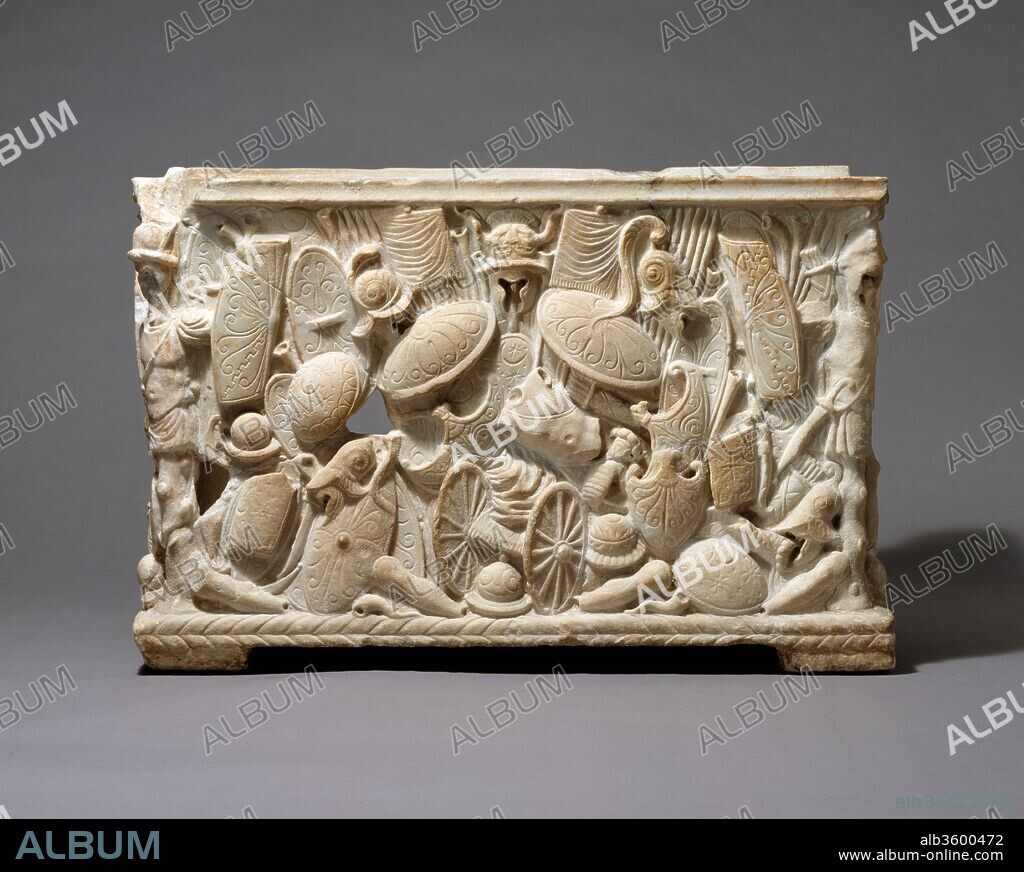alb3600472
Marble cinerary urn

|
Ajouter à une autre Lightbox |
|
Ajouter à une autre Lightbox |



Avez-vous déjà un compte? S'identifier
Vous n'avez pas de compte ? S'inscrire
Acheter cette image.
Sélectionnez l'usage:

Titre:
Marble cinerary urn
Légende:
Traduction automatique: Urne cinéraire en marbre. Culture : romaine. Dimensions : hors tout : 14 1/4 x 21 1/4 x 16 1/8 in. (36,2 x 54 x 41 cm). Date : 1ère moitié du 1er siècle ap. Cette urne cinéraire romaine a la particularité d'avoir pour thème principal le butin de guerre. Malgré le caractère fragmentaire de la pièce, les trophées et piles d'armes et d'armures qui recouvrent le dos et les côtés de la boîte rectiligne sont très frappants. Tant dans le détail que dans la composition, les panneaux sont représentatifs d'un travail de haute qualité, suggérant que le travail était une commande spéciale. Malheureusement, une grande partie de la façade, où aurait été l'inscription enregistrant le nom du défunt, est manquante. L'urne aurait été extraite d'une tombe près d'Anagni, au sud-est de Rome, en 1899. D'autres urnes funéraires en marbre de la collection du Musée (voir 96.9.222a, b ; 25.78.29 ; et 27.122.2a, b ; à l'affiche dans la cour) appartiennent à des formes beaucoup plus courantes de l'art funéraire romain, les urnes cinéraires qui soit ressemblent à de véritables réceptacles (vases ou corbeilles), soit prennent la forme d'autels ou d'édifices miniatures. Dans l'iconographie et l'artisanat, l'urne actuelle préfigure les sarcophages élaborés de la période mi-impériale.
Marble cinerary urn. Culture: Roman. Dimensions: Overall: 14 1/4 x 21 1/4 x 16 1/8 in. (36.2 x 54 x 41 cm). Date: 1st half of 1st century A.D..
This Roman cinerary urn is highly unusual in having the spoils of war as its principal theme. Despite the fragmentary nature of the piece, the trophies and piles of weapons and armor that cover the back and sides of the rectilinear box are very striking. In both detail and composition, the panels are representative of high-quality workmanship, suggesting that the work was a special commission. Sadly, much of the front, where the inscription recording the name of the deceased would have been, is missing. The urn is said to have been excavated from a tomb near Anagni, southeast of Rome, in 1899.
Other marble funerary urns in the Museum's collection (see 96.9.222a, b; 25.78.29; and 27.122.2a, b; on display in the courtyard) belong to much more common types of Roman funerary art, cinerary urns that either resemble actual receptacles (vases or baskets) or are in the form of altars or miniature buildings. In both iconography and craftsmanship, the present urn foreshadows the elaborate sarcophagi of the Mid-Imperial period.
Technique/matériel:
MARMOL
Période:
Early Imperial, Julio-Claudian
Musée:
Metropolitan Museum of Art, New York, USA
Emplacement:
ROMAN EMPIRE
Crédit:
Album / Metropolitan Museum of Art, NY
Autorisations:
Modèle: Non - Propriété: Non
Questions sur les droits?
Questions sur les droits?
Taille de l'image:
4200 x 3360 px | 40.4 MB
Taille d'impression:
35.6 x 28.4 cm | 14.0 x 11.2 in (300 dpi)
Mots clés:
 Pinterest
Pinterest Twitter
Twitter Facebook
Facebook Copier le lien
Copier le lien Email
Email
